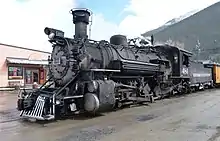Rio Grande class K-36
The Denver and Rio Grande Western K-36 class are ten 3 ft (914 mm) narrow gauge 2-8-2 "Mikado" type steam locomotives built for the Denver and Rio Grande Western Railroad (D&RGW) by Baldwin Locomotive Works. They were shipped to the Rio Grande in 1925 and were first used along the Monarch Branch and Marshall Pass, but were later sent to the Third Division out of Alamosa. Of the original ten, four are owned by the Durango and Silverton Narrow Gauge Railroad (D&SNG) and five by the Cumbres and Toltec Scenic Railroad (C&TS). Number 485 fell into the turntable pit at Salida and was scrapped in Pueblo in 1955, with many parts being saved.
| Denver & Rio Grande Western K-36 class | |||||||||||||||||||||||||||||
|---|---|---|---|---|---|---|---|---|---|---|---|---|---|---|---|---|---|---|---|---|---|---|---|---|---|---|---|---|---|
 D&RGW K-36 No. 488 at the Cumbres and Toltec Scenic Railroad | |||||||||||||||||||||||||||||
| |||||||||||||||||||||||||||||
| |||||||||||||||||||||||||||||
| |||||||||||||||||||||||||||||
| |||||||||||||||||||||||||||||
The locomotives are of outside-frame design, with the driving wheels placed between the two chassis frames which support the boiler, but with the cylinders, driving rods, counterweights and valve gear on the outside. This general arrangement is shared with the earlier K-27, K-28 and later K-37 Mikado engines.
Designation
The locomotives' designation of K-36 comes from two different sources. The K in the designation comes from the locomotives' wheel arrangement (Mikado), and the 36 stands for 36,200 pounds of tractive effort.
In Service
The K-36s were used primarily as freight locomotives out of Alamosa to Durango and to Farmington, New Mexico, as well as out of Salida to Gunnison (over Marshall Pass) until 1955 and to Monarch on the Monarch Branch until 1956. They were built with special valves to allow brake control between locomotives while double-heading and were commonly found between Alamosa, Colorado and Chama, New Mexico. They were heavily used during the pipe boom in Farmington, and hauled long freight trains between Alamosa and Farmington.
In 1937, three K-36s, Nos. 482, 483 and 489, were equipped with steam heat and signal lines to haul passenger trains like the Shavano and the San Juan Express. Eventually, in 1945, Nos. 484, 485 and 488 were also equipped, too.
As of 2020, eight of these locomotives still operate regularly. Nos. 483, 484, 487, 488 and 489 are owned by the C&TSRR and Nos. 480, 481, 482 and 486 are owned by the D&SNG. However, No. 483 is stored out of service at Chama. As of June 2020, No. 489 is temporarily out of service while it undergoes a new smokebox installation during its Federal Railroad Administration (FRA) mandated 1,472-day inspection. However, due to COVID-19, No. 489 is currently expected to return to service in 2021. On December 15, 2020, the C&TSRR announced that, in addition to the 1,472-day inspection and rebuild, No. 489 is also being converted from burning coal to burning oil. No. 489 will be the first and only so far locomotive on the C&TS to be converted to burn oil. In addition, as of early November 2020, No. 480 is also currently awaiting a conversion from burning coal to burning oil and will be the third and last locomotive so far on the D&SNG to be converted to burn oil, the others being K-37 class No. 493 and K-28 class No. 473.
Roster[2][3]
| Number | Photo | Builder's Number |
Current Owner |
Notes |
|---|---|---|---|---|
| 480 |  |
58558 | D&SNG | Retired in 1970. Went to D&SNG in March 1981. Restored to operating condition in July 1985. Operational. Awaiting a conversion from coal-burning to oil-burning as of November 2020. |
| 481 |  |
58559 | D&SNG | Went to D&SNG in March 1981 and was the first K-36 run to Silverton. Operational. |
| 482 |  |
58541 | D&SNG | Retired in 1962. Went to C&TS in 1970. Traded to D&SNG in October 1991 in exchange for K-37 class No. 497. Restored to operating condition in May 1992. Operational. |
| 483 |  |
58584 | C&TS | Retired in 1968. Went to C&TS in 1970. Removed from service in 1977. Almost swapped out with K-28 class No. 478 in 2015 from the D&SNG. Stored in Chama, NM. Undergoing a cosmetic restoration as of 2016. 483 also hauled the last scheduled passenger train on the Denver and Rio Grande Western Railroad on May 29, 1965. It was a fan trip from Alamosa to Durango, Colorado. |
| 484 |  |
58585 | C&TS | Went to C&TS in 1970. Restored to operating condition in 1974. Operational. |
| 485 |  |
58586 | N/A | Crashed in the turntable pit in Salida. Due to severe damage, 485 couldn't be repaired and was scrapped on January 24, 1955. Many parts were salvaged and used on other locomotives. |
| 486 |  |
58587 | D&SNG | Retired in 1962. Went to Royal Gorge Park for display in December 1967. Traded to D&SNG in May 1999 in exchange for K-37 class No. 499. Restored to operating condition in August 2000. Operational. |
| 487 |  |
58588 | C&TS | Went to C&TS in 1970. Operational. |
| 488 |  |
58589 | C&TS | Went to C&TS in 1970. Operational. |
| 489 |  |
58590 | C&TS | Retired in 1962. Went to C&TS in 1970. Restored to operating condition in 1974. Operational. Undergoing FRA mandated 1,472-day inspection and conversion from coal-burning to oil-burning as of December 15, 2020. K-36 489 |
References
- "Denver & Rio Grande Western Mikados". Steam Locomotive dot com. Archived from the original on 21 September 2010. Retrieved 12 February 2010.
- "Denver & Rio Grande Western Roster". Rio Grande Modeling & Historical Society. Archived from the original on 22 November 2008. Retrieved 12 February 2010.
- "Durango & Silverton Steam". DRGW.net. Retrieved 12 February 2010.
| Wikimedia Commons has media related to Denver and Rio Grande Western K-36 class. |